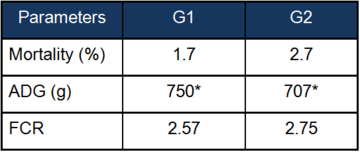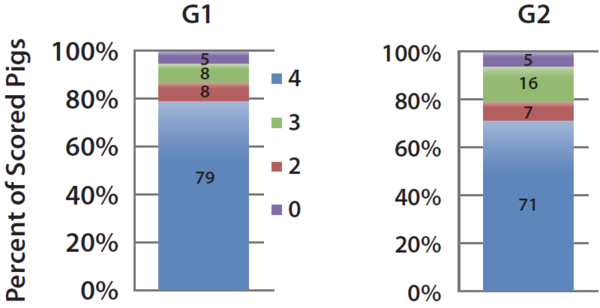.
-->Introduction
-->Results
-->Conclusions
.
EFFICACY OF COGLAPIX® AND HYOGEN® VACCINES IN THE PREVENTION OF PLEUROPNEUMONIA AND ENZOOTIC PNEUMONIA
By Krejci R.1, Merialdi G.2, Luppi A.2, Saldivar D.3, Lopez A.1
1Ceva, Libourne, France, 2IZSLER Italy, 3Ceva Mexico
.
Introduction
Porcine pleuropneumonia induced by Actinobacillus pleuropneumoniae (A.p) and enzootic pneumonia due to primarily Mycoplasma hyopneumoniae (M. hyo)belong to most important and widely spread diseases of pigs. Their control by preventive vaccination was proven in many studies.
Although A.p is a primary pathogen which doesn’t require previous triggering to produce the disease, M. hyo can increase the severity of A.p infection. Vaccination against both pathogens is thus advisable in farms affected by those agents.
The aim of this study was to compare the efficacy of Coglapix® - A.p toxoid vaccine (Ceva) and Hyogen® - M. hyo vaccine (Ceva) with competitor vaccines in the farm with the history of enzootic disease caused by A.p and M. hyo.
.
Materials and Methods
Weaned piglets were divided into two groups (G1 and G2):
- G1: 206 piglets were vaccinated with Hyogen® (M. hyo vaccine) at 3 weeks of age (W), and with Coglapix® (A.p toxoid vaccine) at 12 and 15W.
- G2: 207 piglets were vaccinated with competitor M. hyo and toxoid A.p products using the same program as G1.
Both groups were vaccinated against PRRSv at 2W and PCV2 at 3W.
Mortality, average daily gain (ADG) and feed conversion rate (FCR) were measured in the fattening period. Ceva Lung Program - Scoring Methodology was used to score lung lesions at the slaughterhouse. In particular, a modified Madec1 method was used for evaluating enzootic pneumonia (EP)-like lesions and the SPES2 method for scoring pleurisy. SPES method has 5 different score (0: no lesions; 1: ventro-cranial pleurisy; 2, 3 and 4: dorso-caudal pleurisy of increasing level of severity). Dorso-caudal pleural lesions are considered suggestive of recovered pleuropneumonia3.
^ Top page
.
Results
1. Performance:
G1 group had lower mortality and FCR than G2 and higher ADG for 43g (Table 1). The difference in ADG was statistically significant in favour of G1 (*p<0.05).
Table 1 Comparison of performance indicatiors
^ Top page
.
2. M. hyo-like lesions at slaughterhouse:
Pigs of G1 had lower incidence (*p<0.05) of lungs with broncho-pneumonia (BP lungs) with lower % of affected parenchyma in BP lungs (Figure 1).
Figure 1 Broncho-pneumonic lesion (M. hyo like)
^ Top page
.
3. A.p-like lesions at slaughterhouse
Pigs belonging to G1 showed lower prevalence and severity of dorso-caudal pleurisy than G2, as described inFigure 2.
Figure 2 Dorso-caudal pleurisy lesions
^ Top page
.
Conclusions
In the present study, Hyogen® and Coglapix® conferred higher protection against EP and pleuropneumonia than competitor vaccines. Lung scoring results in slaughter pigs reflect the relation between the level of protection of lungs and most common indicators of performance. For this reason, it can be considered a relevant diagnostic tool in assessing the efficiency of vaccines against those respiratory pathogens.
^ Top page
.
References
Madec F. et al., 1982,J Rec Porc Fr,14, 405-412
Dottori M. et al., 2007,Large Anim Rev, 161-165
Gottschal M., 2012, Disease of Swine, 10th Edition
.
(Source: Axis Issue 02 / Sept 2013 - Ceva Asia Pacific - Proceedings APVS 2013)
.
Related topics: study axis swine coglapix hyogen disease vaccine efficacy pleuro-pneumonia enzootic pneumonia

 Corporate Website
Corporate Website
 Africa
Africa
 Argentina
Argentina
 Asia
Asia
 Australia
Australia
 Belgium
Belgium
 Brazil
Brazil
 Bulgaria
Bulgaria
 Canada (EN)
Canada (EN)
 Chile
Chile
 China
China
 Colombia
Colombia
 Denmark
Denmark
 Egypt
Egypt
 France
France
 Germany
Germany
 Greece
Greece
 Hungary
Hungary
 Indonesia
Indonesia
 Italia
Italia
 India
India
 Japan
Japan
 Korea
Korea
 Malaysia
Malaysia
 Mexico
Mexico
 Middle East
Middle East
 Netherlands
Netherlands
 Peru
Peru
 Philippines
Philippines
 Poland
Poland
 Portugal
Portugal
 Romania
Romania
 Russia
Russia
 South Africa
South Africa
 Spain
Spain
 Sweden
Sweden
 Thailand
Thailand
 Tunisia
Tunisia
 Turkey
Turkey
 Ukraine
Ukraine
 United Kingdom
United Kingdom
 USA
USA
 Vietnam
Vietnam






